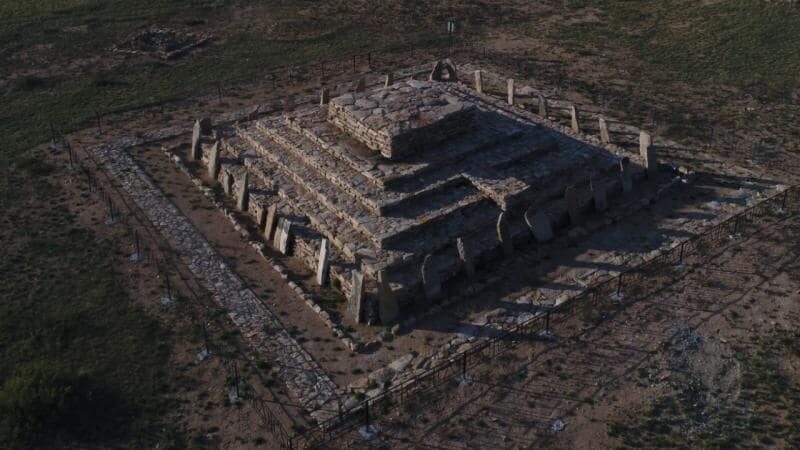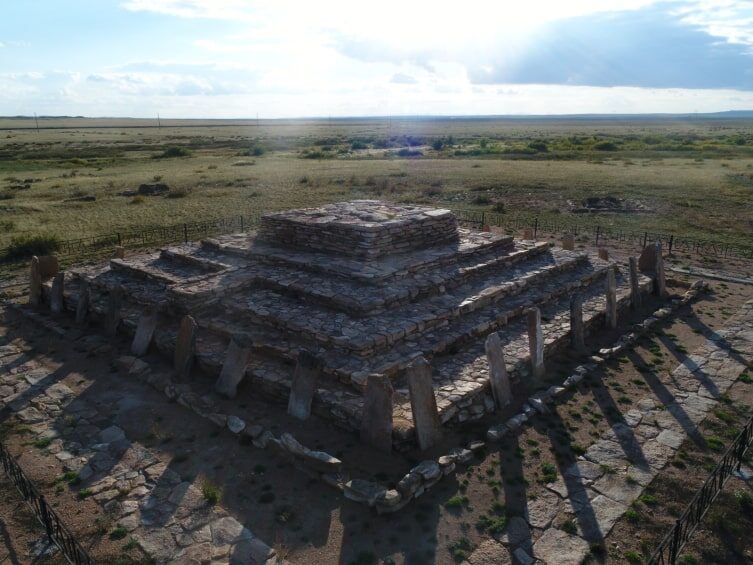
© Dr. Aibar Kassenali
Experts announced that the Karajartas mausoleum belongs to a ruler from the Begazı Dandibay period, which was the last phase of the Andronovo period.
The pyramid, which was excavated over the course of four excavation seasons by archaeologists from Karaganda University, is situated atop a hill overlooking the Taldy River in the Shet district of Karaganda.
From the National Museum of the Republic of Kazakhstan, Dr. Aibar Kassenali made the first evaluation of the discovered pyramid to
TRT Haber.
Dr. Aibar Kassenali announced that according to the results of carbon 14 analyses carried out on the finds, the pyramid structure was dated between the 14th and 12th centuries before Christ (BC).
Dr. Kassenali explains the meaning of this dating: "The presence of multiple pyramidal stepped mausoleums detected in the region shows that the Taldı River valley, located in the Sari Arka steppes, was used by the Andronovo communities in the Bronze Age as the valley of kings where their great leaders were buried, like the Nile Valley in Egypt. " he explained with his words.
Dr Aibar Kassenali said that when the findings in the burial chamber were examined, the steppe pyramid may have been built on behalf of a local ruler who ruled the Kazakh steppes during the Andronovo period.
Dr. Aibar Kassenali said, "Looking at the cut stones found in the pyramid, the size of the mausoleum, and the fact that such a
huge structure was built in the Bronze Age in a very arid region such as the steppe is an indication of the high understanding of art and rich spiritual beliefs that the Begazi Dandibay communities have reached."

© Dr. Aibar Kassenali
Dr. Serhan Çınar noted that there is information about
pyramid-shaped tomb structures in ancient historical sources related to the Scythian-Saka and the early periods of the Begazı Dandibay communities. Dr. Çınar emphasized that the step-like pyramidal monumental tombs identified in Karajartas may be early versions of burial structures from the Scythian period mentioned in historical records.
Excavations in the region have also uncovered a proto-city settlement also belonging to a Begazı Dandibay community.
Dr. Çınar said, "This settlement, which extends over an area of 15 hectares, existed chronologically in the same historical period as Troy 4 in Asia Minor, the Early Mycenaean period in mainland Greece, and the advanced period of the Middle Kingdom in Egypt. The settlement has a series of walls, a planned street network, and water collection systems."
The researchers believe that the Begazı Dandibay communities demonstrate a close relationship with the Proto-Turkish culture, which is derived from the Karasuk culture of Southern Siberia. As a manifestation of traditional Turkish religious belief, the corridors leading to the burial chamber, particularly in the mausoleums of the Begazı Dandibay phase, always open towards the direction of sunrise.
The round-shaped ceramic vessels found in the graves from this period symbolize a cultural continuity in the steppe environment. They represent ritual vessels from the Scythian-Saka period, and in later periods, they evolved into the archaic versions of traditional cauldrons commonly seen among Turkic tribes from the time of the Asian Huns onwards.
It is known that among the Turkic runic script characters from the Göktürk period, there are many tamga pictograms associated with the Andronovo and Begazı Dandibay phases.
Furthermore, the geometric decorations and tamga-type characters (A tamga or tamgha was an abstract seal or stamp used by Eurasian nomads and by cultures influenced by them) found in burial sites are present in the art of medieval Turkic tribes, indicating ethnographic and historical continuity.
Reader Comments
Agreed on currently accepted history.
Most of us were taught that the Americas, for instance, were not populated at the same time as the Akkadian Empire and if they were, the people were simple cave-dwelling hunter-gatherers. We now know advanced cultures spanned both North and South America and had complex trade networks from Isle Royale in Lake Superior where copper was mined 14kya (and the copper has been found in heirloom goods in Europe that came back to NA with the Europeans) all the way down to Tierra del Fuego.
I've studied the esoteric my entire adult life, but I am not an experiencer thus far. I think the universe is far more complex than those who believe in the high fantasy version of reptilians/silurians. If only reality was as simple as good vs. evil. Black and white thinking leads to atrocities, as we can see all around us. Good vs. evil is as absurd as it is simple.
As for your friend, you could just mentally dismiss him as a solipsist and focus on what you like about his company instead. If you really wanted put him to the test you could ask what came before God created the universe 4500 years ago and take him down that path to insanity. "Give us one miracle and we'll explain the rest" is what the critics of the big bang theory say. And if he believes everything in the bible is true, ask him earnestly when the last time he talked with God was. I'm not even religious, but I do know that I've had communion with God at least twice.
I feel disclosure is in full-effect, now, for me - but see that that has always been the case. None of the dramatic issues I'm experiencing in life started 3 years ago...I can see the seeds going back to childhood. There seems to be more of a hard line between the "sides", but I've been studying this stuff since 911. So now it's almost a daily exercise of "who might I offend today".
I find the nuance of understanding among people fascinating, such as the left siding with Palestine. In conversation I'll find a consensus on something like that, will concede that the vast majority of people will find it difficult "when they finally understand what's going on" -and then find the conversation is bend to: Humans and Climate Change ®™
My wife always says that an argument cannot be won by getting louder - so I try gently to practice my interlocution skills.
I guess more importantly, target-wise, our local university does plenty of biological research for the government.
Cyberattacks in multiple US states disrupts factories, Israel's gov't adopts new 'wartime digital powers'
An Iran-linked hacking group is "actively targeting and compromising" multiple U.S. facilities for using an Israeli-made computer system, U.S. cybersecurity officials say. Comment: Not only are...Pictures look like it was excavated years ago or longer.
Terrible reporting from so-called Dr's in the field.
in a different article it said this is the fourth consecutive season they've dug it, so four years ago?